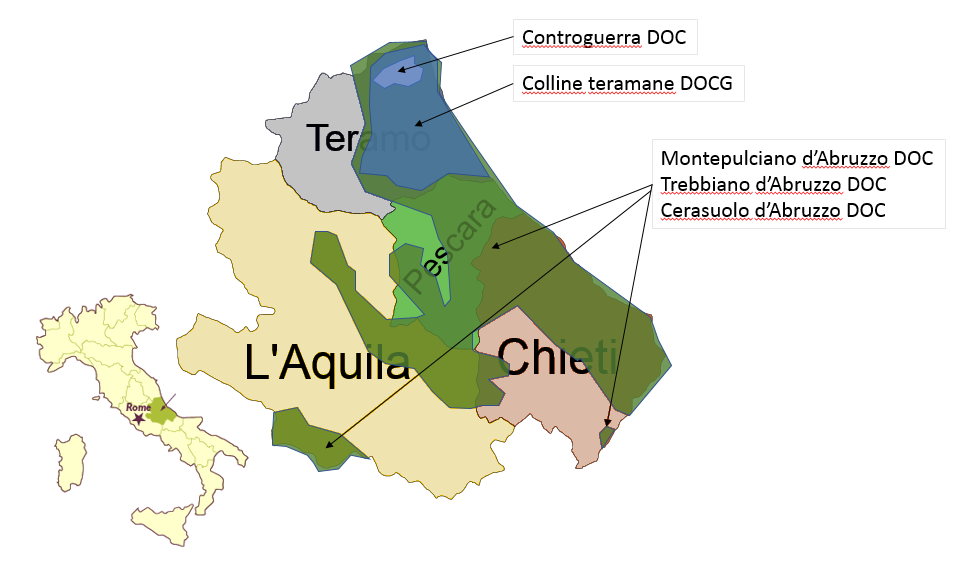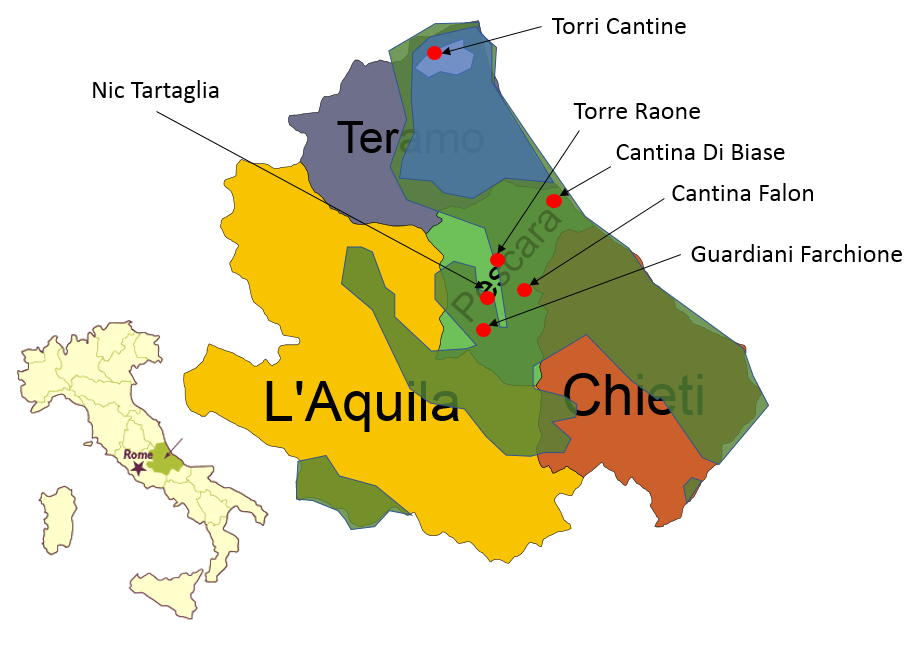Abruzzo
Known as 'the greenest region of Europe.'
The Abruzzo region is located in the centre of the Italian peninsula east of Lazio and Rome. Abruzzo as one third of its territory, the largest in Europe, set aside as national parks and protected nature reserves.It is bordered to the west by the Apennines and to the east by 150 kilometres of coastline on the Adriatic Sea. It is one of the wildest and most mountainous areas of Italy. The Corno Grande in the Gran Sasso massif, at 2914 metres, is the highest peak of the Apennines, and the Majella, with its 2793 metres, dominates the landscapes. There are many rivers, and although many of them are seasonal, there are a lot of them that are fed all year round, even during the hot summer season. The three most important rivers that flow to the Adriatic are the Pescara (152 km) in the centre, the Sangro (122 km) to the South and the Tronto (115 km) to the north. Abruzzo counts 500 square kilometres of national parks, where rare species of the Mediterranean flora and fauna survive. Abruzzo has 4 provinces: Pescara, Teramo, Chieti, and L'Aquila, the latter, located in the mountain ranges, being the only one not bordering the Adriatic Sea.
 Abruzzo DOCs
Abruzzo DOCs
Variety sets Abruzzo appart
Abruzzo has about thirty thousand hectares of vineyards. It contains 5 DOCs: Abruzzo (Montepulciano d'Abruzzo, Trebbiano d'Abruzzo, Cerasuolo d'Abruzzo, Pecorino d'Abruzzo), Controguerra, Terre Tollesi, Ortona, Villamagna as well as a DOCG: The Montepulciano d'Abruzzo Colline Teramane. Alongside these DOCs, the region also has 8 "Indicazione Geografica Tipica (IGT)": Colline Aprutini, Colline del Sangro, Colline Frentane, Colline Pescaresi, Colline Teatine, vastese (or Histonium), Terre di Chieti and Valle Peligna.
The whites, the rosés and the Reds all get married exceptionally well with the varied cuisine of the region.
The Trebbiano of Abruzzo, a leading white wine, is a consumer favourite that complements seafood or vegetable dishes. The native grape variety, Pecorino, is one of the trendiest native varieties of Italy at the moment and produces a richer, creamier and more saturated white that is resistant to meat and poultry.
Abruzzo is also one of the few Italian regions to be able to claim a long tradition for the production of rosé wines. A long time ago, farmers and peasants had become accustomed to making more clear wine from their classic Montepulciano varietal of Abruzzo for their daily consumption, really made a variation of rosé typical to the region. Today, these wines are identified by the denomination Cerasuolo of Abruzzo. A very colorful "rosé" wine, when vinified according to traditional methods, but very dry and with character.
Most of Abruzzo's red wines are made with the Montepulciano grape, which gives an ink color, intense aromas and soft tannins. These reds are perfect for lamb, grilled steak or grilled meats.
The wine of Abruzzo fits beautifully with meal, but its biggest attraction is the quality value offered to consumers.
Obviously, in front of such a choice of varietals combined with a wide variation of terroirs, microclimates and producers, Olkades regularly travels through Abruzzo to offer you the best products, while embracing this unique diversity. The starting point is to know the grapes, the terroirs, then the climate and above all, the producers seeking to make quality and not quantity.
Abruzzo Grapes
Montepulciano requires a warm climate. It has a very pigmented skin, moderate acidity and softer tannins than many other Italian grape varieties. Montepulciano d'Abruzzo is a red wine made from the Montepulciano grape and produced only in Abruzzo. It should not be confused with the Vino Nobile di Montepulciano of Tuscany, a wine made from Sangiovese.
The Trebbiano ...
Unfortunately, trebbiano does not have a good reputation with many wine lovers. Although there are differences between the multiple sub-varieties.
Trebbiano di Soave (or trebbiano di Lugana), this last name refers to the delicately scented white wines that are vinified using this grape in the Lugana DOC in Veneto. As surprising as it may seem, this sub-variety of Trebbiano is not really Trebbiano, but Verdicchio (Bianco).
The trebbiano toscano thrives mainly in Tuscany. This sub-variety is the most planted of all trebbiano in Italy (more than 40,000 hectares!). Ubiquitous throughout Italy, it guarantees much higher returns, but is much more commonplace. It is also this variety that you find in France under the name ugni blanc.
The Trebbiano Giallo that is abundantly found in the appellations of Castelli Romani and can sometimes be 'amabile' (very slightly sweet).
Trebbiano Modenese, Trebbiano Romagnolo and Trebbiano Spoletino are local variants of Emilia-Romagna and Umbria.
Finally, Trebbiano Abruzzese from DOC Trebbiano d'Abruzzo. The Trebiano Abruzzese is the grape variety and the Trebbiano d'Abruzzo the DOC. Often confused with bombino bianco, Mostosa, Passerina or Trebbiano Toscano, Trebbiano Abruzzese is a different variety that produces high-quality wines.
Pecorino is currently producing the most popular white wine in Italy. An early maturing variety that easily accumulates sugar, Pecorino wines are rounder and higher in alcohol than Trebbiano d'Abruzzo. Almost forgotten until the 1980s, when the variety was rediscovered in the Marche, Pecorino wines are reminiscent of those of Sauvignon Blanc, offering aromas and flavours of sage, green fig and winter melon. Due to its growing popularity, there is a lot of Pecorino wine these days, but many hardly remind us of the variety. Pecorino is a mountain variety that likes higher slopes. Due to its popularity, it is now also grown on the plains with rather disappointing results. So be suspicious and check the location of the vines. The producers selected by Olkades are all at ideal altitude for optimal quality of the wines produced.
Coccociola has a green skin that usually produces straw-coloured wines with high acidity and herbaceous flavours. Traditionally used in blends, it is used in a varietal under IGT Colline Aprutini and Colline Teatine.
The Passerina also known under the names 'Pagadebito Gentile'. 'Campolese' and 'Uva Passera'. Passerina is derived from Passero, which refers to the sparrow who has a fond appetite for this variety.
Climates
Colline Teramane is located near Teramo. It can be subdivided into three valleys (Val Vibrata, Val Tordino and Val Vomano). The soils are mostly marl and clay and often tinged with red, while the climate is usually warm. The Montepulcianos of Colline Teramane can be quite powerful (especially the Riservas). Although highly publicized, it is a young production area whose real winemaking potential has not yet been fully exploited.
The Pescarese is divided into two sub-areas; Vestina (or Terre dei Vestini) and Casauria (or Terre di Casauria). The first is located in the north: Loreto Aprutino, Spoltore and Rosciano are important wine towns. The landscape presents low hills with exposures to the sea. The microclimates vary greatly: the area of Spoltore is closer to the sea and warmer, Rosciano and especially Loreto Aprutino are influenced by a hilly topography. Casauria, located to the south of the Vestina region and west of Pescara, is more mountainous, extending to the west in the Apennine mountains (Alanno, Bolognano, Cugnoli, Popoli and San Valentino are important wine towns of the region). The vineyards of Casauria turn to the east, to the sea and to the west. It's also located in a much cooler microclimate. The day-night temperature variations are greater and produce fresh, mineral white wines with good aging potential, while its Montepulciano wines are among the finest in Abruzzo.
The Chieti is a vast area with the Vastese to the south, mostly flat, with a more mountainous area surrounding the towns of Guardiagrele and San Martino sulla Marrucina which benefits from a generally cooler microclimate and higher limestone soil content.
L'Aquila, a very mountainous region, with soils that have higher gravel content. Quality viticulture is possible in more temperate areas. Despite the mountainous landscape, it is hot here in the summer: Ofena is nicknamed the "Abruzzo Forno" (oven of Abruzzo).
Where can you find our producers :
 Producers
Producers
New Generation
Abruzzo has long been known to be a region that was content to produce big red wines and rather simple white wines. But this has changed rapidly, and the region is now one of the most interesting regions of Italy. With iconic producers like Emidio Pepe and Edouardo Valentini who have decided to produce wines of very high quality, now follows a generation of young producers who took over the family vineyards to make great wines. The new generation of producers favours vineyards in altitude, unlike the vineyards of the plains near the sea. The vineyards in altitudes benefit from a climate much more favourable to culture which will produce quality wines. Winemakers are also much more selective in the use of barrels, and use them more judiciously to produce fine wines. All the recent changes in the Abruzzo vineyard means that Abruzzo wines are one of the best value for the consumer.
Recent Vintages
2016: The year began with an unusually warm winter, which led to an early bud break, then the frost hit hard in late April. Summer was normal, but with a fresh month of August. The rain marked the month of September throughout the harvest for the whites. The red wines seem particularly promising, since the grapes were generally harvested after the rainy period. The Pecorino did particularly well in Colline Teramane.
2015: Superb vintage. Heavy rain in the spring providing good water reserve. July, August and September were very hot without rain, which allowed a culture without disease. Production was down by 20% in some regions, but for the majority of Abruzzo production was up 5% compared to 2014. The harvest took place about ten days earlier than usual, with August temperatures reaching 40 degrees for several days. The vintage is very successful in red.
2014: A very rainy year with rains that started early and continued the whole season. The whites and the Cerasuolo have succeeded rather well.
2013: A cool and rainy spring. Summer had a more stable spell, which compensated and offers us reds with great potential. On the other hand, the rains of September caused problems for producers who harvested too early rather than waiting for the rain to eventually end.
2012: A more favourable vintage in Abruzzo than for many other regions of Italy, where it was often too hot. Winter and spring provided good water reserves which made it possible to withstand the heat of summer.
2011: One of the hottest years in Abruzzo, accelerating all growth phases in the vineyard. An early harvest and wines with a hot vintage personality.
2010: An exceptional vintage for all wine (red, white and Cerasuolo)
